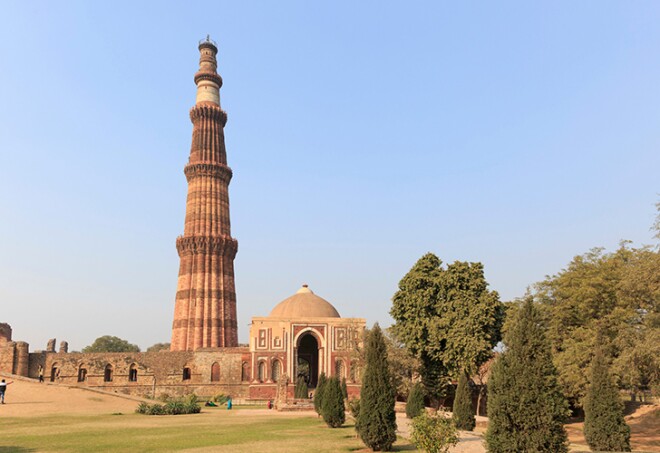Standing tall in the heart of Delhi, the Qutub Minar is an iconic symbol of India’s rich history, architectural prowess, and cultural diversity. As a UNESCO World Heritage Site, this towering minaret, surrounded by intricate structures and historical remnants, tells a story of dynasties, creativity, and the passage of time.
Architectural Splendor: Built in the early 13th century, the Qutub Minar is a masterpiece of Indo-Islamic architecture. It showcases a fusion of Islamic and Indian artistic styles, incorporating intricate carvings, inscriptions, and motifs that depict the cultural diversity of the era. The tower’s red sandstone and marble construction exude elegance and grandeur.
Historical Legacy: The Qutub Minar was commissioned by Qutb-ud-din Aibak, the founder of the Delhi Sultanate, as a victory tower to celebrate his triumph over Hindu rulers. The construction continued under different rulers, with additions by Iltutmish and Firoz Shah Tughlaq. The minaret stands as a testament to the rise and fall of various dynasties.
Tower of Victory: The Qutub Minar stands at a height of around 73 meters, with five distinct stories, each adorned with balconies and intricate carvings. The first three stories are made of red sandstone, while the upper two stories are crafted from white marble and sandstone. The tower tapers as it rises, creating a visually stunning effect.
Intricate Carvings and Calligraphy: The Qutub Minar is adorned with intricate Arabic and Nagari calligraphy, as well as geometric and floral patterns. The inscriptions recount the tower’s history and its builders. The engravings represent a blend of cultural influences and are a testament to the artistic finesse of the craftsmen.
Iron Pillar: Adjacent to the Qutub Minar stands an Iron Pillar, an enigmatic structure that has stood for over 1,600 years. Made of exceptionally pure iron, this pillar has withstood centuries of weathering without significant corrosion. The inscriptions on the pillar offer historical insights and remain a subject of scientific curiosity.
Qutub Complex: The Qutub Minar is the centerpiece of the larger Qutub Complex, which also includes other historically significant structures like the Quwwat-ul-Islam Mosque, the Alai Darwaza, and the Tomb of Iltutmish. This complex is a treasure trove of architectural and historical wonders that transport visitors back in time.
The Qutub Minar stands as a towering testament to India’s architectural brilliance, historical legacy, and cultural diversity. As you stand beneath its soaring heights, you’re transported to an era of dynasties, conquests, and creative expression. The minaret’s intricate carvings, impressive proportions, and rich history make it a symbol of India’s enduring past and a must-visit destination for those seeking to explore the tapestry of the nation’s heritage.

